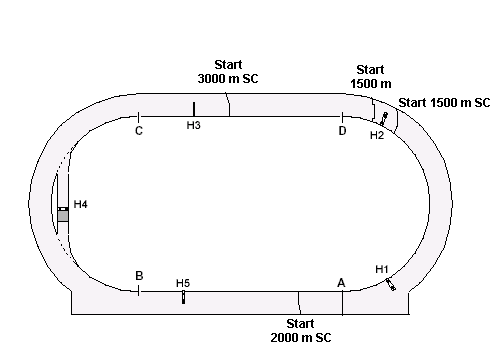 | STEEPLE TRACK SETUP
The drawing above illustrates information below for meet venue managers and officials concerning the position of start lines and the on-track hurdles placement for the three most commonly contested steeplechase distances: 1500m, 2000m, 3000m.
The letters A, B, C, D show tangent points where straightaways meet turns. "A" is the common finish line, prevalent in the age of fully automatic timing, on the home straightaway of a 400-meter oval.
The letters H1 through H5 represent jumps encountered by steeplers. H4 is the water jump; the others are on-track steeple hurdles whose position is determined by the location of water jump because the distance between jumps is approximately one-fifth of a "steeple lap".
The length of a "steeple lap" is determined by the placement of the water jump -- on a "steeple path" which is usually inside Lane 1 of the oval's second turn. If that steeple path is ten meters shorter than running in the track's first lane, then a "steeple lap" is 390 meters and the distance between jumps will be 78 meters. (5 x 78 = 390) This concept was charted in the 1973-74 IAAF Handbook. It can still be seen in NCAA Rule 1-3.4.
The drawing above depicts a "steeple lap" of 395 meters as a consequence of the steeple path being five meters shorter than running in the track's first lane. This positions the start line for a 3000m steeple 35 meters back of tangent point C, the start of a 3000m flat race. It positions the 2000m steeple start 25 meters back of tangent point A, the start of a 2000m flat race. And it positions the start of 1500m steeple 15 meters back of the start line for a 1500m flat race.
Each of those steeple distances will provide about 250 meters of running without jumps, giving runners some time to unpack.
Athletes in a 3000m steeple race will not face H3, H4, or H5 during their first half lap of running. Their first jump is H1 and they will face five jumps, including the water, in each of seven complete "steeple laps" or a total of 35 jumps in the race.
Athletes in a 2000m steeple race will not face H1 or H2 during their first half lap of running. Their first jump is H3, followed by H4 and H5 during their first lap. Thereafter they will face five jumps in each of their remaining four laps -- a total of 23 jumps in the race.
Athletes in a 1500m steeple race will not face H2, H3, or H4 in their first half lap of running. Their first jump is H5. Thereafter they will face five jumps in their remaining three laps -- a total of 16 jumps in the race.
The on-track hurdles not faced by athletes during their first 250 meters are nearby and are moved onto the track as soon as the runners pass by; those hurdles will be there when the runners reach that location again.
How is that athletes in a 1500m or 3000m steeple do not encounter H4, the water jump, during their first 250 meters of running? Answer: The 1500m and 3000m steeplers run initially on the track, passing the water jump; the next time around they will be guided onto the steeple path by cones, flags, or pointing officials. The 2000m steeple competitors must enter the steeple path the first time they encounter it.
All three steeple distances have been contested on the University of Oregon track in Eugene. At other venues, where only the 3000m steeple has previously been offered, there will be an initial need to locate the starting line for 1500m and 2000m steeples. Here is an easy technique:
1. Measure distance from tangent point C to existing start line for 3000m steeple.
2. Divide that measured distance by seven = distance saved by each use of steeple path.
3. Multiply "distance saved" by five = distance back of tangent point A to 2000m steeple start.
4. Multiply "distance saved" by three = distance back of 1500m run start to 1500m steeple start.
Although the drawing shows an ideal location for water jump, as seen in TV of many major meets, some venues also position the water jump inside the curb but closer to tangent point C than to point B. That positioning can make on-track hurdles location awkward. Hurdle 1 will be perilously close to the finish line; confronted with this, some meet venues have made ad hoc decisions that confound steepling basics and rules. A better solution is to move the water jump to the global standard location shown in the drawing.
Locating the water jump "outside" of the oval's outer lane, though relatively rare, creates a "steeple lap" of about 420 meters and sometimes longer. That can reduce the safety run-up without jumps until reaching the first hurdle of a 3000m steeple race. For a 2000m steeple race, the 420m (or longer) "outside steeple lap" has engendered irregularities such as wrong race distance or missing jumps.
Interestingly, the outside steeple lap creates no harm for a 1500m steeple. It merely moves the start line forward onto the backstretch. This suggests that the 1500m steeple ought to be the global standard for younger "junior" and "youth" steeplers, plus the older "masters," because it can be contested even at venues that cannot properly host a 2000m steeple. In other words, the 1500m steeple is venue-neutral.
The map-like drawing above resembles an illustration that has appeared for more than 20 years in the rulebook of the USA Federation; the coding reflects a similar illustration of the German Federation.
-- Text by James Fields |
|